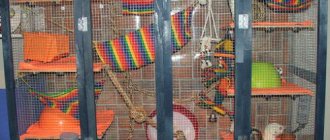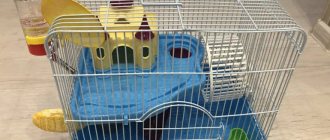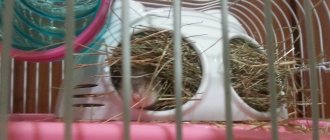- home
- Housing
16.04.2018
Almost everyone has a day when they need to properly organize their move. The difficulty often lies not in small children, but in their pets. It is imperative to find out how they tolerate this or that type of transport and how to transport it without harm to the health and life of the hamster. Choosing a carrier for an animal is not difficult, but we must not forget the rules of transportation and the necessary equipment of the home.
Air travel
You can transport your hamster over short and long distances using different types of transport. Before transporting an animal on an airplane, you need to find out how this species tolerates stress on the body. Veterinarians warn that dwarf hamsters and Syrian hamsters do not withstand such stress well. Having understood the characteristics of the rodent, you can move on to choosing a container.
It will be difficult to adapt to the requirements of the airline and the country where the hamster’s owners are moving. You need to prepare documents for export from the country in order for your pet to be allowed on the plane.
In addition to your own troubles, you can also harm your pet. You need to think 10 times before finally deciding that there is no other way to transport a hamster. The animal may not survive the air travel at all. With the above species of rodents, there is a possibility of death from stroke due to pressure surges.
Varieties of walking balls for hamsters
There are several options for a hamster accessory. Classic spheres allow the animal to run in any direction. If owners do not want their pet to move chaotically around the apartment and want to make its route predictable, a ball with a track will suit them.
With or without stand
Balls without a stand cannot be fixed. The hamster will be able to run around the whole house in them. If the owners do not want the pet to disturb guests or run away during a visit to the veterinarian, it is better to take a product equipped with a stand.
Ball materials
Only lightweight plastic spheres are suitable for hamsters. Metal and wood are too heavy for rodents. In addition, they limit the view. The pet will constantly bump into obstacles while inside such a container. Glass is not suitable as a material due to its fragility. If the ball breaks, the hamster may be injured. Be sure to check whether the plastic is toxic. Even a small dose of toxic substances can lead to the death of a small animal.
Hamster balls are made of plastic.
With or without fastening
Fasteners are needed to secure the door. They make the product safer, but may impair mobility. The owners personally decide whether they need this accessory.
Brief overview of popular models
- Plastic. Easy to clean, you can observe the animal through the transparent top. Versatile: can be used for both short trips and long trips.
- Carrying bag. Made of dense fabric, ventilation and a window for observation are provided. The animal bag is suitable for transportation over a short distance.
- With metal rods. It resembles a familiar cage for a rodent, the most budget option. The bottom is made of plastic so that filler can be poured in and it is more convenient for the pet to move around the container.
A nesting house for budgerigars: is it needed and why, how to choose and make it yourself.
You can make a simple carrier yourself.
How to make your own carrier?
How to make toys for a hamster with your own hands at home
Many people are interested in whether it is possible to make a carrier for such an animal as a hamster with your own hands. It's actually quite simple. In addition, in this way you can save additional financial resources that would be spent on purchasing a carrier for transporting an animal on a train, for example.
There are several options for homemade carriers designed for hamsters. These include:
In the first case, it is extremely important to make sure to make several holes in the transport container to allow sufficient oxygen to enter the baby’s temporary home. Otherwise he may suffocate
In the second case, you should give preference to strong, breathable fabrics, since, experiencing a feeling of strong fear and anxiety on the train, the pet may chew off part of the homemade container.
Some people prefer ordinary glass jars so that the baby cannot get hurt during the move on sharp corners, which are often present in homemade carriers made for hamsters
In addition, it is important to consider that when traveling on a train or other types of transport, the animal will still experience a shaking sensation, and therefore it is worth checking from time to time how it behaves and whether everything is okay with it. In order to understand how to make a carrier for a hamster, just watch the training videos, of which there are plenty on the Internet
Which carriers are not suitable?
Some carriers are made in the form of a small cage made of rods, but in winter such a device can cause hypothermia in the hamster. Therefore, it is better to leave the open cage for the summer season. There are also carriers on sale made of thin plastic, but hamsters, like any other rodents, can easily chew through the walls or base and escape. For the same reason, you should not give preference to homemade cardboard boxes, although this option is very tempting in terms of saving money.
Choosing a Carrying Bag
How to make a maze and tunnel for a hamster with your own hands
When purchasing a container for your hamster, you need to pay attention to several details:
- Carrying size. A small container is suitable for transportation. If the rodent requires a lot of free space, then you can choose a larger one.
- Material. Metal containers are practically no different from a rodent’s usual home and have a low cost. It is most convenient to use a plastic container - it is easy to wash, the hamster will not be able to chew through the hole, and there is enough light from above. Animal bags made of fabric are suitable if you need to transport the animal over a short distance.
- Price. There are both very cheap models and more expensive containers. You need to choose based on the financial capabilities of the owner and the necessary properties of the container. The main thing to remember is that low price = fragility and unreliability.
Transportation by wheeled transport
The most adequate method of transportation is traveling by car, since in this case the animal can handle the road much easier. This is especially useful within the state, then you will not need a transportation certificate.
If you are planning to transport a hamster in winter, then you need to know that rodents hibernate if they feel the prolonged effects of cold. The hamster's carrier should be well protected from frost, and the owner should try to stay outside with the baby as little as possible.
Sometimes hamsters have to leave their home cage and go on a journey. The owners are moving to a new home, going to the veterinarian, or even going on vacation - the reasons can be any. Owners are faced with an important question: how to transport a hamster? Holding an animal in your hands is not the best idea; dragging a cage with you is also not very convenient. Special carriers for hamsters were invented especially for this purpose.
- Is it possible to do without carrying?
- Basic provisions for transporting hamsters
- Temperature
- Features of containers
- Transporting a hamster using different means of transportation
- Transportation by wheeled transport
- Air travel
- Travel by rail
- Choosing a Carrying Bag
- Brief overview of popular models
- DIY hamster carrier
- Hamster carrier - video
- Conclusion
Animal bag
A carrier for hamsters is necessary not only for travelers, but also for walks in the fresh air. The right container will provide a comfortable home for the duration of your walk or trip.
Hamster carriers are sold in regular pet stores. You can choose a container to suit every taste and budget. The price depends on the size and model. Varies from 10 to 20 dollars. For 15 you can find a durable plastic carrier, which will have holes for air and devices for the animal’s comfort. Approximate container size for hamster comfort: length at least 20 cm, width – 30 cm, height – 25 cm.
Main types of carriers:
- The bag has a window and air flows in. Suitable for very small pets.
- Plastic ones are transparent, let in more light to the hamster, and are easy to wash.
- Metal - for those who need to save money. The advantage is that there is almost no difference from the usual rodent home.
When purchasing a carrier, you need to consider the availability of amenities:
- Containers for food and water.
- Drum, ladder and other entertainment.
Such carriers will be more expensive, but then you don’t have to worry too much about the comfort and safety of the hamster. Before going to your pet’s new home, it is better to put old sawdust, he will feel a familiar smell and will not be afraid of the journey.
Is it possible to take a hamster on vacation?
We're going on vacation by car and there's no one to leave the hamster with for three days on the road, can we take it with us or could it die?
in a cage you can. and don't let it go so you don't get lost
Well, why drag him with you? Hamsters are nocturnal animals. During the day they sleep. Why do you need all this trouble? This is not a dog or cat, which can get sick without your attention. The main thing for a hamster is to eat and sleep. Place yourself with family or friends while you are away.
Nothing will happen to him! Food and water, and you will only go out into the air from the car and take him with you in a cage, otherwise you will leave the poor thing there! ))
Any shaking is harmful for hamsters, and even more so traveling by car. And hamsters should absolutely not be disturbed during the day; this may even shorten their already short lifespan. The hamster must SLEEP all day - this is the nature of these animals. And he probably won’t be able to sleep well in the car. In addition, the animals are nocturnal, and heat, bright light and the sun are far from useful to them. From the heat and overheating, they immediately begin to drool and then, very quickly, die. Therefore, the best thing to do is leave it with friends. A hamster is not a kitten, there are no problems with him, since he only eats and sleeps, and he doesn’t need anything else in his life. If he rustles at night, then let him put the cage in the bathroom. I just can’t believe that among your friends there are no people who would not agree to shelter a HAMSTER for such a short time.
If it's summer, it will be very hot, and there is a smell of gasoline in the car. We took the hamster and he felt very bad. He then slept for a day. Put a head of cabbage in the cage, more water... And more breadcrumbs. And there is no need to carry it anywhere.
It’s possible, the main thing is to feed and water, don’t forget, then he won’t die
Source
How much does a hamster carrier cost?
The cost of the carrier depends on its material, the manufacturer’s pricing policy, and the filling of the container.
Plastic container
The most convenient for hamsters is a plastic container. It is spacious; if necessary, you can place not only feeders and drinking bowls in the container, but also your ward’s favorite toys. When purchasing, make sure that there are ventilation holes, the quality and environmental friendliness of the material, it should also be strong enough.
Product price:
- from 135 to 400 hryvnia (Ukraine);
- from 410 to 1,700 rubles (Russia).
Did you know? In Vietnam, keeping hamsters as pets is prohibited by law, with a fine of up to 30 million dong (approximately 50 thousand rubles). The ban is based on the fact that rodents are carriers of infectious diseases.
Ball carrier
The carrier ball is not suitable for long trips. This item is basically intended for gaming. But for short distances it can be used quite well. The advantage of the ball is that no matter how it turns over, the baby will not get hurt or injured, since the inside of the ball is soft and elastic.
The material is durable on the outside and has holes for fresh air to enter. The disadvantage of the carrier toy is that with prolonged use, the lid covering the hole wears out. To be on the safe side and not lose your pet, you can glue the lid with tape during the walk.
Balloon prices:
- from 23 to 60 hryvnia (Ukraine);
- from 252 to 749 rubles (Russia).
About 20 minutes into the ride, the woman felt something furry touch her left ankle.
The second time this happened, Amanda decided to see what was going on there. And I saw a hamster sitting under the clutch pedal. But there was no place to stop on the road, so she had to drive home, where she immediately jumped out of the car and saw a fur ball flash under the pedals. All evening Amanda tried to lure the fugitive out of the salon, but in vain.
Basic rules of transportation
Before organizing the relocation of hamsters, it is worth buying a container for the hamster. It is much more convenient, adapted for transporting animals on a train, allowing the animals to bury themselves in the sawdust poured inside and sleep the entire way. The animal carrier must be equipped with containers for water and food, and in no case should it be placed in a draft or left where it is very cold. To reduce the stress of pets during transportation, it is worth following its basic rules in various types of transport.
In airplane
For hamsters, transportation by plane is highly undesirable. There is information that Djungarians and Syrians may not survive the flight at all, dying from a stroke, which occurs due to sudden changes in pressure
In addition, it is important to find out in advance the conditions for transporting animals, because when checking documents, if some of them are missing, the pet will be confiscated
By train
Transportation by train is one of the most successful “travel” options for individuals of the hamster order. The main thing is to make sure you have the following documents:
- form No. 1;
- certificate for transportation (taken from the state district clinic);
- ticket indicating “baggage with you.”
If you are planning to travel on a train for a long time with your pet, you should take care of a large number of accessories inside the temporary home so that he does not get bored and does not feel the change in the situation around him.
By car
When thinking about whether it is possible to transport a hamster in a car, you should not look for reasons to refuse such an idea. This method of transportation is considered one of the most convenient when it comes to traveling from one city to another within the same country. The animal will not need any additional certificates about its health status or vaccination. Pet carriers used in the car must be well insulated, especially in the winter. It is best to wrap them in scarves, warm blankets, and put as much sawdust and napkins inside as possible so that the pets do not freeze.
Transporting hamsters to a new place of residence.
4 messages
Basic rules for transportation: It is better to transport in a spacious (relatively for small) closed carrier (terrarium) in winter, and a small cage in summer. The undoubted advantage of using an ordinary small cage as a shipping container is that it is easy to attach a nipple drinker, as well as very good air exchange
It is important that the animal has a place to turn around, play a little and sleep. -Before the trip, you can accustom the hamster to a cage/carry. Place sawdust and some old bedding in the carrier. Take food and water on the road (offer water regularly, especially if you are carrying it in a terrarium or plastic carrier, because
you can’t attach a drinking bowl there), favorite treats. - The cage or carrier should be in a bag, which should be spacious enough so that the animal does not experience problems with oxygen. And even if you transport a hamster in a terrarium/plastic carrier, this cannot always be done without additional insulation, so in this case a bag will not be superfluous. In the cold season, you can place bottles/heaters with hot water between the carrier and the walls of the bag, and in the heat, on the contrary, bottles with ice/cold accumulators; with this placement of cooling/warming elements, the animal will not get burned or freeze. - For transporting animals, you can use both regular sports bags and special bags designed for transporting animals. If you are using a duffel bag to carry the container, it should be larger than the carrier. And you don’t need to close the zipper of the bag all the way: leave a small hole through which air will enter the bag. Fulfilling this condition will guarantee good air exchange and will be the key to your pet’s well-being. It is very convenient to use a bag for transporting cats and dogs for this purpose; any carrier can be included there; the bag perfectly protects the animal from the cold (some have a temperature regulator) and from prying eyes, and, thanks to the mesh on one of its sides, creates excellent air exchange for the animals .-Indoors (train station, airport, compartment, car/airplane), the bag must be opened in order to keep an eye on the animal and provide it with better access to oxygen. Unlike short trips, such long trips are always very stressful for both animals and their owners in particular.
Transportation by car, bus, taxi, metro.
In warm months (spring, summer), transport your hamster in any public transport, cars, only those equipped with air conditioning, since there is a high probability of the animal getting heatstroke. If your car is not equipped with air conditioning, then you need to follow the following rules in order to in order not to expose the life of your pet to mortal danger: Carry out transportation only late in the evening, or at night, and only when the evening air temperature outside does not exceed 25 ° C. The carrier should be spacious, with good ventilation, ideally it should be mini - a cage, not a terrarium, and not a glass jar. There must be a drinking bowl with water, and something from succulent food (green apple, greens). Always offer water yourself. To cool the hamster (in hot and stuffy weather) during a trip, the outside of the carrier (cage) should be lined with cold (bottles or ice packs, cold batteries), it is better to place cooling elements on top, because cold air is heavier than warm air and sinks down, but good air access is necessary, and the greenhouse effect should not be allowed under any circumstances. Do not allow drafts in the car. Constantly monitor the hamster on the road, so that urgent measures can be taken in case of overheating. Transport in winter time is preferably in a warm, heated car, the carrier is only closed (not a cage) + wrapped in a blanket, placed in a non-breathable bag, lined with bottles/warmers with hot water, and plenty of sawdust in the carrier itself.
https://ohomjakah.ru/soderzhanie/perenoska-dlya-homyaka-i-konteyner-perevozka-v-transportehttps://homjakam.ru/zhile/perenoska-dlya-homyakahttps://vk.com/topic-64168749_30452563
Documents for air travel with animals
Transporting an animal must be agreed upon with the airline in advance, as... the number of seats for pets is limited. Regardless of whether you are flying with a parrot or a goldfish, the pet must have the necessary package of documents:
- Veterinary passport.
- International veterinary certificate (for foreign flights).
- Veterinary certificate in form No. 1 (for domestic Russian ones).
- Microchipping certificate.
- Documents required by the legislation of the country of arrival (for example, a certificate of absence of infections, breeding value, etc.).
At the airport, before departure, your pet must go through control at the veterinary station.
Why do you need a carrier for hamsters?
The hamster is a small but nimble and at the same time fragile animal; it is susceptible to colds after being in the cold for a long time.
Important! If you carry a baby in your own pocket or bag, in your bosom, this can, at the very least, result in damaged clothes, in another case, injury, loss of a pet, or even death.
Therefore, when going to a pet store to buy a pet, transporting an existing one to a veterinarian, or traveling with a ward, you need to think carefully about where it will be kept during this period.
Animals, like us, experience stress, fear, and other natural desires and needs. By providing the hamster with familiar conditions in a transfer or relocation situation, you will neutralize all negative consequences. In the carrier, the hamster is, firstly, safe, and secondly, warm.
It will also be useful for you to find out what a cage for a hamster should be like, how to make and arrange an aquarium for a hamster, and also find out what a cage should be like for a Djungarian and Syrian hamster.
Temperature
When transporting a pet, you need to pay attention to weather conditions. Extremely high and low temperatures can have a detrimental effect on an animal's health.
In summer, keep the container with your pet in the shade to avoid sunstroke. Hamsters do not tolerate cold easily, especially frost. It is possible to transport a hamster in winter, but you need to monitor your pet more closely. If he is exposed to cold air for a long time, he may fall into a stupor. Place napkins in the carrier and cover the container with a scarf or blanket. It is important to keep your hamster warm.
Parrots and other birds on an airplane
After cats and dogs (read the rules for transporting them here), the most popular pet passengers are birds. First of all, because a much larger number of airlines are ready to accept them on board than, for example, fish or rodents. The parrot's flight must be coordinated with the airline no later than 48 hours before departure. And at the same time, find out the exact requirements for a container for transporting birds. The cage must be strong and have a secure lock. All accessories inside the cage (bowls, branches, toys) are secured (tied to the rods).
All toys and other accessories must be securely attached to the bars of the cage during the flight.
The bird can be transported in the cabin or luggage compartment. It’s better in the salon - the owner can correct the shortcomings in time and just talk to the pet. In addition, the luggage compartment has poor ventilation, which can cause serious injury to the bird.
How to prepare a bird for air travel
Birds are transported in a cage or carrier bag; it is better to introduce the pet to its temporary home in advance Read: What to do if your luggage is lost during a flight
A few tips to help reduce your bird's stress during air travel:
- To make it easier for your feathered pet to endure the journey, it must be accustomed to the cage in advance.
- You should bring a dark cloth with you to cover the cage during the flight (some airlines provide such a cover).
- If at home the parrot prefers to live a free life, before going on the road it is better to accustom it to a long stay in the confined space of the cage.
- Often a week before the trip, the bird is given stress vitamins. But only an ornithologist veterinarian should prescribe it.
- Before the flight, the bird should be given something to drink, and fresh, liquid-rich fruits should be placed in a bowl.
On the third day, Amanda again came to the car service, where news about the hamster was again waiting for her.
The giggling mechanics kindly informed her that the animal was clearly not going to stop, because during the night it had managed to break the passenger airbag. In addition, it will take several hours of work to repair anything that was chewed by a hamster. As a result, Amanda was advised to vacuum the interior for now and place safe traps everywhere in order to still catch the destroyer.
How to transport hamsters: food
Use dry grain food for hamsters, and instead of water, you can use pieces of juicy vegetables or fruits (not citrus fruits). Apples, carrots, bell peppers, cucumbers, tomatoes, eggplants and grapes are suitable - they will prevent dehydration.
The answer to the question of how to transport hamsters is not complicated: following the above tips will ensure the comfort of your little pets.
Caring owners very often faced the problem of transporting their pets. The cold season causes particular inconvenience for small rodents. First of all, if you carry a hamster in your hands, it can run away, and the owner, dressed in a thousand clothes, cannot deftly catch him. Also, exposure to low temperatures can cause detrimental harm to the animal. Therefore, when you plan to transport your hamster to new owners in winter, you should approach this issue as seriously as possible.
WE SELECT AND EQUIP THE CARRIER
Hamsters do not tolerate cold and drafts well. The best option for transporting them is plastic containers with a hatch and ventilation holes. They provide access to fresh air into the carrier and prevent drafts. In hot weather, you can use a small cage with metal bars, less than 15x15x10 cm in size.
Many people are interested in whether it is possible to transport a hamster in a homemade container? You can make a carrier yourself. To do this, you need to take a regular plastic container and make several small holes for air on top. A rodent can only be transported in a glass jar over short distances.
Special sawdust or soft paper is used as bedding. You can put some sawdust from your pet's cage, then the hamster will feel comfortable surrounded by a familiar smell. When transporting in cold weather, it is recommended to add more sawdust to make it warmer.
TEMPERATURE AND VENTILATION
Adequate ventilation must be ensured with multiple air openings. In summer, you need to make sure that direct rays of the sun do not fall on your hamster. Overheating is dangerous for the animal, it can get heatstroke. Ventilation openings must not be blocked.
If it is winter outside, during the move you should not keep the container with the hamster close to heating appliances. It is dangerous to place the carrier under a warm heater or on a stove. It is better to place it under a warm jacket.
When transporting a pet, you should adhere to a number of rules:
- Do not place objects in the carrier that could injure the animal if shaken.
- Do not play with your hamster and try not to disturb your pet during the trip.
- If you need to transport your hamster in a car, hold the carrier in your hands. This will reduce the intensity of shocks while the vehicle is moving.
Use dry grain food when moving. Do not use sippy cups as water may spill and wet the carrier. Instead, add pieces of juicy vegetables or fruits that will prevent dehydration.
Almost everyone has a day when they need to properly organize their move. The difficulty often lies not in small children, but in their pets. It is imperative to find out how they tolerate this or that type of transport and how to transport it without harm to the health and life of the hamster. Choosing a carrier for an animal is not difficult, but we must not forget the rules of transportation and the necessary equipment of the home.
How to make a carrier for a hamster with your own hands
If buying a ready-made carrier for some reason is not your option, you can make it yourself. For this purpose, you need to purchase a food-grade plastic container (preferably rectangular in shape), with a lid and handles of a suitable size.
Food-grade plastic guarantees that your child will not breathe harmful fumes during transportation.
DIY hamster carrier: video
Tools and materials
Tools and materials required for work:
- food plastic container;
- soldering iron;
- a soft belt or handle from an old bag.
Manufacturing process
The production diagram looks like this:
- Using a soldering iron in the upper part of the lid, at a distance of approximately two centimeters from the corner, we solder a narrow groove so that the holder from the drinking bottle can be secured in it. For ease of use, it is better to remove the lid from the container.
Then try the lid on the container box and remove a piece of plastic at the point where the container wall comes into contact with the drinking bowl mount. Place the drinker in the mount, mark the place for the hole for the drinker spout in the wall of the container. Solder a hole of the required size so that the spout fits freely inside the container.
Next, to prevent the pet from suffocating, we solder holes in the form of parallel strips in the three corners of the container in the lid, two or three are enough. The fourth corner of the lid, near which the drinking bowl is attached, is left untouched.
The final stage is to equip the carrier with everything necessary for the hamster’s comfort:
- Place a feeder with dry food on the bottom.
- Scatter sawdust around the bottom of the feeder, level it and compact it.
- Tie a soft long belt to the lids of the container, old handles from a bag, you can sew a handle from existing scraps of fabric. Adjust the length of the handles for your own convenience, and it is better to tie them obliquely so that the box does not warp during transportation of the pet.
- Close the lid and install the drinker, lift the handles up and click into place. The carrier is ready.
Sew a baby carrier - step by step instructions, pattern diagram
After everything is prepared, you can go directly to creating the carrying bag.
Click on the diagram to enlarge.
Step 1. Take measurements
This step will not be easy to complete, but it is very important to perform it accurately. We need to understand exactly what size our container should be
It should be large enough so that the cat can change its body position from time to time. It is desirable that the height inside is enough for the animal to stand on its paws, and the length should not be pinched from the tail or head.
Step 2. Draw out the pattern of our product on paper. As you can see from the photo, the scheme is very simple. We only use our own sizes!
Step 3. Cut out the layout from paper and fold it, as if presenting the finished product. This will help avoid miscalculation, and the future cat bag will fit.
Step 4. If the pattern fits, transfer the details to the fabric and cut out all the necessary parts. There should be two parts for each part - from the main material and the lining.
Step 5. Sew the main and lining together with the right sides facing inward. Then we turn it inside out and the seam remains inside.
Step 6. We sew cardboard into the base to provide a “hard surface” under the pet’s paws.
Step 7. Sew on the zippers.
Step 8. Be sure to leave mesh windows so that air can flow in and also so that the cat can see what is happening outside.
Step 9. Sew on strong, reliable handles, decorate if desired. The handles can be made from the same fabric, or you can use old ones from another bag.
The result is a comfortable, free soft container made by the caring hands of a loving owner.
If the above method seems overwhelming, then you can show your imagination and make a carrier from an old bag by cutting a hole in the side and covering it with a fabric or metal mesh:
The main thing to remember is that portable bags should be safe and comfortable, and first of all for the animal.
Fish on the plane
The main difficulty with transporting fish on an airplane is that they live in water. And its volume, as a rule, exceeds 100 ml - the maximum limit for liquid in one bottle in the aircraft cabin.
Therefore, the vast majority of airlines refuse to transport fish.
Most likely, the aquarium fish will fly in the trunk
For example, Aeroflot airline is not ready to accept them in any form, just like rodents. If you can find a carrier that is prepared for such unusual passengers, most likely they will fly in the luggage compartment. Please note that airlines are not responsible for the safety of fish.
What to transport fish in
Aquarium fish are transported in a strong, sealed container without corners or dangerous elements. The most popular options are a jar, thermos or plastic container. However, it is better to use multi-layer sealed bags. This way, when shaking, the fish are not injured by the walls of the container. The package is placed in a box (usually foam).
How to prepare for air travel of aquarium fish
The bag cannot be filled completely with water and oxygen; under pressure during the flight it may burst. Rules for air travel of fish:
- Before the flight, the fish need to fill the aquarium with fresh water - preferably 3 degrees below the usual norm. This will make the journey easier for them.
- The fish are moved into containers or sealed bags before departure and the recently replaced water is poured into them. The ratio of water to air is 2:1.
- A more preferable option is to ask the pet store to fill the container with water, saturating it with oxygen at the same 1:2 ratio.
- Do not overfill the container with oxygen or air (the surface of the bag should be slightly pressed when pressed). At flight altitude, the pressure decreases and the volume of air increases.
- Before the trip, the fish are not fed for a day - well-fed fish consume more oxygen.
- Do not transport many fish in one container. At a minimum, 1 liter of liquid is required for one 5-centimeter individual.
- The container must be darkened - fish tolerate stress more easily in the dark.
- During the cold season it is necessary to provide heating. For example, cover a bag with waterfowl pets with heating pads.
Read: Carry-on luggage on an airplane, size and weight, what you can carry
Rules for flying with rodents
The general rules for air transportation of a chinchilla, rat, guinea pig or transportation of a hamster on an airplane are as follows:
- Transportation is carried out in factory-certified containers that must correspond to the dimensions of hand luggage.
- It is necessary to provide all the required basic and additional (you need to clarify their need with the consulate or the airline) documents.
- You will need to go through veterinary control at the airport.
- It is necessary to check whether this type of rodent is on the Rosselkhoznadzor list.
- If there is, then everything is fine. If not, you will need to obtain an individual permit to import/export the animal according to the international CITES list.
It is especially important that when transporting rodents on an airplane, the cage must have a dense frame and good ventilation. Sharp corners are unacceptable to prevent injury to the animal, and when transporting rats on board an airplane, a reliable lock will be required.
Carrying for the chinchilla during the flight
As for specifically transporting chinchillas in the cabin, you will need to proceed as follows:
- Find a public veterinary clinic in your area.
Find out the opening hours, take the chinchilla and go to get a “veterinary certificate” authorizing transportation of the animal by plane.
The certificate must indicate the full name of the accompanying person, the point of departure and arrival, a note indicating that the animal has undergone all vaccination and quarantine measures, as well as a note about deworming. One certificate allows you to transport two chinchillas.
- Buy a closed type carrier with a rigid frame.
- Find the airline representative at the airport and confirm the transportation of the chinchilla.
- Take a carrier with rodents, a veterinary certificate, a passport, a ticket and go to the veterinary control point at the airport. A veterinary control representative examines the chinchillas and puts a stamp (issues a boarding pass) on the veterinary certificate (the procedure is usually paid).
- You go to registration and then to security. Go through the metal detector and then through the scanner. But don't put your chinchilla carrier on the luggage belt.
- During the flight, never remove rodents from carriers in the aircraft cabin. Do not feed or water your chinchillas during the flight, as this will make it easier for them to bear it.
All information about the rules for transporting rodents must be clarified directly with the carrier.
It is important to note that many airlines do not allow rodents on board because they are a potential threat to the safety of the aircraft, as they can easily crawl into some crevice. In addition, proximity to rodents may be undesirable and even dangerous for other passengers.
For example, when transporting rabbits on an airplane, allergy sufferers often experience attacks of bronchial asthma or other allergic reactions. That is why it is so important to clarify all the information about transporting your furry friend with the air carrier in advance. In addition, even if you manage to take your pet out, it is not a fact that upon arrival in another country they will be able to accept it. Therefore, check in advance whether you will be allowed to bring your rodent to the place where you plan to fly with it.
Thus, if you familiarize yourself with the airline's rules in advance and strictly follow them, transporting a bird, turtle, rodent or other small animal on an airplane will be easy and comfortable - both for you and for your pet.
Sometimes hamsters travel with their owners, so to ensure everything goes smoothly, you will need a hamster carrier. With such a device, you can transport your baby to a new place of residence, on a visit, or take it with you on vacation. It is more convenient to transport in a container than in a regular cage, because it is bulky. The hamster is not picky when transporting, but the owner must make sure that he has food and water
It is important that air enters the carrier; it should not be left in the cold, near heating devices
Is it possible to transport a hamster on a train? Definitely yes, and you can use a hamster container for these purposes. Plastic retains heat - just put a little of the usual bedding on the baby, he will burrow and sleep the whole way, especially if the journey falls during the daytime.
Travel by rail
It's easier here than in the air. But the majority of those who transported pets in this way are clear that the handlers do not really like such passengers, since they are convinced that they are contagious. Therefore, you must take the appropriate documents and a carrier for your hamster.
The carrier can be purchased in the form of a container for transporting animals. Place shavings or other filler there for the hamster's convenience. And take his favorite food. There is nothing difficult about it.
You must have the following documents with you:
- Form No. 1.
- Certificate of permission for transportation.
- When purchasing a train ticket, indicate “baggage with you.”











